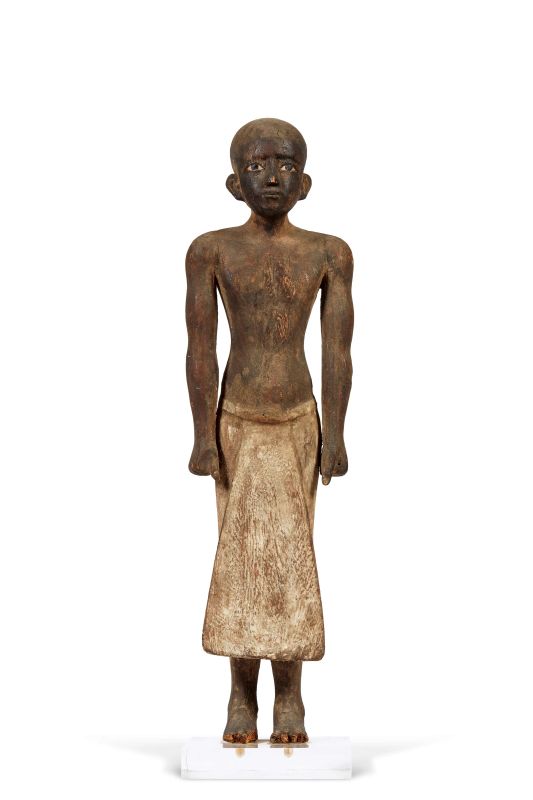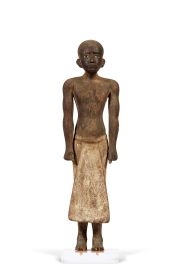FIGURE OF AN OFFICIAL
Egypt, mid-second millennium BCE
h. 63 cm
An export licence is available for this lot
The wooden statue portrays a standing male figure, his shoulders straight and his arms at his sides. The legs are almost parallel; the left leg is only slightly advanced. The shorn head is inclined slightly forward; the facial features, the supraorbital ridges, the nose and the mouth are rendered with accentuated differences among the planes. Stone eyes, carved separately and inserted in the otherwise finished piece, complete the face. The hands are closed into fists; the left hand displays a perforation for insertion of an attribute, now lost. The flesh tone used on the figure is a dark brown.
The man is bare-chested and wears a long white kilt that falls from the waist to mid-calf. The garment is held in place at the top by a band; a downward-flaring trapezoidal panel or apron characterises the front.
The sculpture portrays an official of high standing. It is probable that it originally stood on a base, perhaps made of a different wood, which also quite probably bore dedicatory or commemorative texts such as to permit identifying the subject. However, statues of this type should not be considered portraits, but rather portrayals of individuals’ ka (spiritual entity and life-force), eternally youthful and in perfect form. In the words of well-known Italian Egyptologist Sergio Donadoni, ‘In the main, Egyptian sculpture springs from the desire to provide a point of physical support for a given “soul” (if we may call it that) which is defined by the singularity of its name. The statue is not a monument, a celebratory memorial; it is a specific form of the person; it possesses vitality in virtue of the rite performed over it to “open its mouth” (just as was done with the body after mummification). This fact cannot be overly stressed if we are to understand the roots that nourish the Egyptian figurative experience and what meanings accrue to its typifying vocation and to its vocation for realism.’ (S. Donadoni, L’uomo egiziano. Rome-Bari 1990, p. 277).
The iconography faithfully reprises that used in the case of high-ranking Middle Kingdom individuals: solely as examples, with analogous renderings of the garment (type D.3a – Harvey 2001), the statue of Senbi at the Metropolitan Museum of Art of New York (inv. 11.150.27 – D. Arnold, ‘Statuette of Senbi Standing’ in A. Oppenheim et al., (eds.), Ancient Egypt Transformed: The Middle Kingdom. New York, 2015, 146-50, no. 80 (Fig. 1) and the small male figure from the Rhode Island School of Design Museum (inv. 11.033 - C. M. Woodward et al., A Handbook of the Museum of Art, Rhode Island School of Design. Rhode Island 1988, 96, no. 3 (Fig. 2).
The figurative models of the Middle Kingdom carried over into period of political uncertainty that followed the end of the 12th dynasty and ran through the Second Intermediate Period into the 18th dynasty (Harvey 2009, p. 5). In favour of dating the sculpture to the New Kingdom – a dating confirmed by archeometric analyses (Fig. 3) – are (with respect to the schematic rendering of the preceding period) the figure’s greater dynamism and the more accurate modelling of the musculature and the anatomy.
One particularly important aspect of the precious sculpture presented here is the excellent state of the colours – not only the white of the kilt but also the figure’s brown flesh tones. The fact that the skin seems to be unusually dark-hued could be a sign of the artisans’ desire to imitate ebony, a precious imported wood used in pharaonic statuary – think, for example, of the busts of Queen Tiye (Berlin, Ägyptisches Museum, inv. 21834/17852) or that of her husband Amenhotep III (Brooklyn Museum, inv. 48.28) – or, in exceptional cases, for private statues such as those of the priest Amenhotep and his wife Rannai (Moscow, Pushkin Museum, inv. I.1.а 2103, 2099).
Bibliographical References
Differently from what has been the norm for quite some time now in the case of stone statuary, it is only relatively recently that comprehensive studies of the Egyptians’ wooden sculpture have been undertaken. A systematic work cataloguing 240 Old Kingdom works is available (J. Harvey, Wooden Statues of the Old Kingdom. A Typological Study. Leiden-Boston 2001), but for the works of the Middle and New Kingdom we must still make reference to studies of single works, to mentions in general repertoires (J. Harvey, ‘Wooden Statuary’ in Willeke Wendrich (ed.), UCLA Encyclopedia of Egyptology. Los Angeles 2009) or to treatises on statuary (J. Vandier, Manuel d’Archéologie égyptienne, III. Les grandes époques: la statuaire. Paris 1958).
Our thanks to Dr. Anna Giulia De Marco (University of Pisa), who is now preparing a study on this sculpture, for her input to drafting of this description.
Provenance
Private collection
Accompanying Documents
Documentation of the results of C14 analysis conducted by CEDAD (CEntro di DAtazione e Diagnostica) at the Department of Mathematics and Physics ‘Ennio de Giorgi’, University of Salento, signed by Prof. Lucio Calcagnile.


















